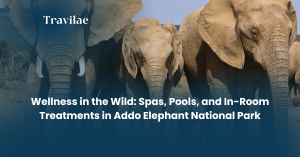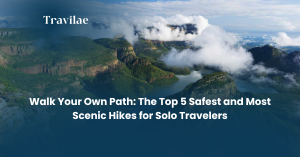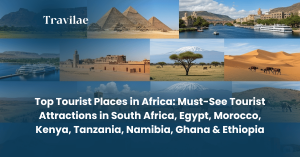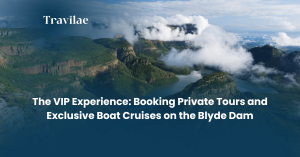The world falls away into a breathtaking abyss of green and stone. The only sounds are your own steady breathing, the crunch of your boots on the path, and the ancient whisper of the wind moving through the ravines. This isn’t a quick stop at a viewpoint; this is a profound, multi-day immersion into one of the planet’s most staggering landscapes. This is the Blyde River Canyon Trail.
For the true adventure traveler, the one who believes the greatest rewards are earned through effort, this trek is a pilgrimage. In 2025, as more of us seek to disconnect from the digital world and forge a genuine connection with nature, this iconic South African hike offers an unparalleled opportunity. It’s a journey that tests your limits and awakens your senses, leaving you with more than just photos—it leaves you with a story etched into your very being. For solo hikers, budget backpackers, and seasoned trekkers alike, this guide is your first step towards conquering the third-largest canyon on Earth.
Table of Contents
The Blyde River Canyon Trail at a Glance
This legendary hike is a serious undertaking, not to be confused with the short walks at the main viewpoints. It’s a challenging, point-to-point journey that requires self-sufficiency and a spirit of adventure.
- Typical Duration: 3 days / 2 nights (a 5-day version also exists but is less common).
- Total Distance: Approximately 33 km (from Paradise Camp to Bourke’s Luck Potholes).
- Difficulty: Moderate to strenuous. The terrain is mountainous with significant elevation changes.
- Accommodation: Basic, rustic hiker’s huts with limited facilities.
- Key Feature: Traversing incredibly diverse landscapes, from misty mountain grasslands and fynbos to dense riverine forests, with constant, awe-inspiring views of the canyon.
The Journey, Day by Day: A Trail Itinerary
The classic trail unfolds over three unforgettable days, each offering a different facet of the canyon’s beauty.
- Day 1: Paradise Camp to Watervalspruit Hut (Approx. 3 km) This is a deliberately short and easy first day to allow for travel and preparation. The trail begins at the God’s Window loop and meanders through beautiful grasslands dotted with weathered quartzite rocks before descending into the Watervalspruit valley. The hut provides a perfect, isolated spot to settle in and mentally prepare for the days ahead.
- Day 2: Watervalspruit Hut to Clearstream Hut (Approx. 13.5 km) This is a long and scenically diverse day. The path takes you through a landscape of strangely sculpted, lichen-covered rocks and into the Treur River valley. You’ll skirt deep ravines and pass through patches of indigenous forest, with the canyon’s sheer cliffs as your constant companion. The day ends at the Clearstream Hut, located near two beautiful waterfalls.
- Day 3: Clearstream Hut to Bourke’s Luck Potholes (Approx. 13.6 km) The final day is another long but rewarding stretch. The trail follows the Treur River, passing the impressive New Chum Falls. It eventually re-enters the nature reserve just before the world-famous Bourke’s Luck Potholes, marking the confluence of the Treur and Blyde rivers and the dramatic start of the canyon proper. Reaching the visitor centre at the Potholes is a triumphant finish to an epic journey.
Are You Ready? Fitness and Mental Preparation
The Blyde River Canyon Trail is not a walk in the park. A good level of hiking fitness is essential.
- Physical Prep: You should be comfortable walking for 6-8 hours with a weighted backpack. Incorporate long day hikes with elevation gain into your training. Focus on leg strength, core stability, and cardiovascular endurance.
- Mental Prep: This is a wilderness experience. You must be prepared for variable weather, basic accommodation, and the mental challenge of a multi-day trek. A positive attitude and the ability to adapt are just as important as physical strength.
Gearing Up: The Essential Packing List
Packing light but smart is crucial. You must carry everything you need for the duration of the hike.
- The Big Three:
- Backpack: A comfortable, well-fitting 50-65 liter pack.
- Sleeping Bag: A good quality, lightweight sleeping bag is non-negotiable.
- Hiking Boots: Sturdy, waterproof, and well-worn-in boots are your most important asset.
- Clothing:
- Moisture-wicking hiking shirts and pants/shorts.
- Warm fleece or mid-layer.
- Waterproof and windproof rain jacket and pants.
- Several pairs of quality hiking socks (wool or synthetic).
- Warm hat and gloves for cold nights.
- Swimsuit for river dips.
- Cooking & Food:
- Lightweight stove, fuel, and cooking pot.
- Spork, mug, and bowl.
- All your food for 3 days (high-energy, lightweight options like dehydrated meals, oats, nuts, and bars).
- Water bottles or hydration reservoir (at least 2-liter capacity).
- Water purification tablets or a filter.
- Other Essentials:
- First-aid kit.
- Headlamp with extra batteries.
- Sunscreen, sunglasses, and a wide-brimmed hat.
- Map and compass/GPS device.
- Toiletries (including toilet paper).
- Power bank for electronics.
(Image: The simple, rustic exterior of one of the trail’s hiking huts, nestled in a valley with the mountains rising dramatically behind it.) Alt Text: The rustic Watervalspruit hiking hut on the multi-day Blyde River Canyon Trail, a simple shelter amidst the wilderness.
Booking Your Trek: Logistics and Planning
This trail must be booked in advance, as only a limited number of hikers are allowed at one time.
- Booking: All bookings are typically handled through the Mpumalanga Tourism and Parks Agency (MTPA) or a registered booking agent like Eco Trails SA.
- Logistics: The trail is a one-way route. You will need to park your vehicle at the end-point (Bourke’s Luck Potholes) and arrange for a shuttle to the start-point (Paradise Camp). This is usually coordinated as part of the booking process.
Home on the Trail: The Hiking Huts
The overnight accommodation is basic and part of the adventure. Do not expect luxury.
- Facilities: The huts (Watervalspruit, Clearstream, and Old Mine) are simple structures with bunk beds and mattresses. They have eco-friendly toilets and, in some cases, cold showers. There is no electricity.
- What to Expect: You will be sharing dormitory-style rooms with other hikers. You must bring your own sleeping bag, cooking equipment, and all food. The huts provide shelter and a place to rest, fostering a wonderful sense of camaraderie among fellow trekkers.
Finding Your Way: Navigation and Safety
The route is marked by yellow footprints painted on rocks, but they can sometimes be faded or far apart.
- Stay Alert: Pay close attention to the markers. In misty conditions, it can be easy to lose the path.
- Carry a Map: A proper trail map is essential. A GPS device with the route pre-loaded is highly recommended as a backup.
- River Crossings: Be prepared to get your feet wet. After heavy rain, rivers can be higher and require careful navigation. Never attempt to cross a dangerously swollen river.
When to Go: Choosing the Best Season for Your Hike
- Summer (November – March): The landscape is lush and green, and the waterfalls are at their most powerful. However, this is the rainy season, so be prepared for frequent afternoon thunderstorms and thick mist that can obscure views and make navigation difficult.
- Winter (May – September): This is the most popular time to hike. The days are generally dry, sunny, and clear, offering the best panoramic views. However, the nights and early mornings can be extremely cold, with temperatures dropping below freezing.
The Challenge and The Reward: Pros and Cons
| Pros | Cons |
|---|---|
| An epic sense of accomplishment and wilderness immersion. | Requires a high level of fitness and self-sufficiency. |
| Absolutely breathtaking and constantly changing scenery. | Accommodation is very basic and rustic. |
| Far fewer people than the main tourist viewpoints. | The weather can be unpredictable and challenging (mist, rain, cold). |
| Excellent value for a multi-day adventure. | Logistics require careful planning (booking, shuttles). |
| Fosters camaraderie with fellow hikers on the trail. | You must carry a heavy pack with all your gear and food. |
Your Questions Answered: Hiking FAQs
Q: Is there potable water available on the trail? A: You can get water from the streams and rivers along the route, but it is essential to treat it before drinking using purification tablets or a filter.
Q: Is the Blyde River Canyon Trail safe? A: The main risks are related to the challenging terrain and weather. The trail is in a nature reserve, and while encounters with large game are rare, it’s important to be aware of your surroundings. The biggest safety precautions are being physically prepared, packing correctly, and having reliable navigation tools.
Q: Can I do this hike solo? A: While it’s physically possible, it’s always recommended to hike with at least one other person for safety. If you do go solo, make sure you are an experienced hiker and that someone knows your exact itinerary.
Q: Are there any parts of the trail that are closed? A: Occasionally, sections of the trail may be closed for maintenance or due to environmental factors. It is critical to confirm the full route is open when you make your booking. The section from Bourke’s Luck to the Swadini resort is permanently closed to hikers.
Is It Time to Take the First Step?
The Blyde River Canyon Trail is more than a hike; it’s a rite of passage for any serious adventure traveler in South Africa. It will challenge you, push you, and maybe even break you down a little. But it will also build you back up, leaving you with an indelible sense of perspective and a deep, quiet confidence. If you’re ready to earn your views and create a story that will last a lifetime, it’s time to start planning. The trail is waiting.






